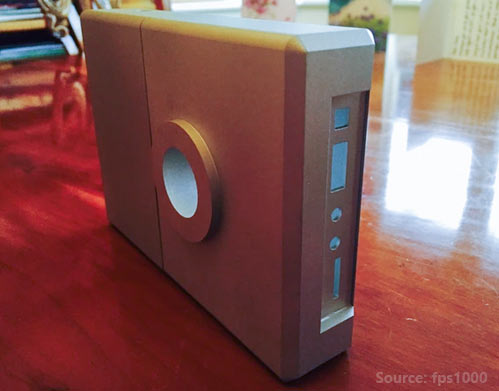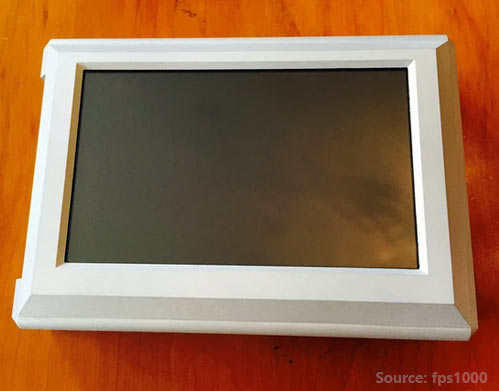Warning: The parent company of FPS cameras “The Slow Motion Camera Company Ltd.” went out of business and entered liquidation proceedings. No further development of cameras is expected. More information here on Google Search!
The awaited update on the status of the fps1000 cameras has been posted on the Kickstarter page and once again it is twisting things up a bit by adding things, improving others and fixing some issues. The most important part of the update relates to what most backers are interested in which is the ship date and this update also starts to set a near time frame for building the first cameras and shipping them as soon as August 2015. While this date can move as it has in the past it seems that the hurdles for getting the improved from original design camera to buyers hands have been surmounted. It will be interesting to see how these cameras perform once in the field and what the software is like.
We dissect the status update point by point and after clarification from Graham rowan on a few issues regarding the hardware changes we are ready to share the insights. So lets dig in…
fps1000 Status Update July 26th 2015
Final Stages by Graham Rowan
The latest and hopefully the last revision of the motherboard is being assembled now. This incorporates the power supply fixes and battery configuration. After some experiment I settled on the use of 2 cells (7.4v) with a more sophisticated sequence of step-down voltages to reduce the power dissipation. The use of a single cell caused noise problems as the 3-4v range of the cell required a switching regulator around the critical 3.3v used by the sensor. The new boards should be back next week.
HSC: This is in line with the previous update regarding the battery use, it looked inelegant to use only a single battery but with this fix you still get the power of two batteries and issues with overheating are resolved. Glad to see the 2 battery cells back in the body.
The first batch of cases will also be here this week with the lens mount and tripod mount threaded. I eventually went for black. This means that I should be able to assemble completed cameras and start shipping next month if all is well.
HSC: The first batch of cameras will be the lower specced hardware like the Silver, Gold and Platinum Standard models. These use a small sensor that will not be obscured by the C mount opening which the mount is based on. Earlier mock ups in the last update did not have threads but the new finalized case is threaded and ready for assembly. There was an initial comment of the camera being anodized red but the choice of black in our view is better and will make the camera less visible, good for shooting close ups with reflections in a set and to be inconspicuous outside.
4K Update
The 4K design is also complete now. Thanks to all those of you who have given me feedback on this. I’ve also been looking closely at the current 4K state of the art. I’m really happy with the final design. I’ve managed to keep to the same form factor of the camera – in fact the new motherboard is compatible with the current one. The case will be the same size except for the slightly increased depth to accommodate the MFT lens mount.
HSC: The 4k design should incorporate much more memory at 128GB and the requirement due to the APS C nature of the sensor does require a larger mount opening which is why the use of Micro 4/3 as a mount is ideal on this camera. The sensor remains the same which is still unreleased information for competitive reasons but it should perform well in low light and deliver outstanding image quality.
The new motherboard has an HDMI 1.4 output which I realize is a pre-requisite for many of you. I’ve also replaced the USB3 as the means of retrieving data from the camera at high speed. This did not fit well with my goal of a non-tethered camera. There is still a high speed USB2 interface for a command interface and software updates but…
HSC: HDMI is back in the 4k version with spec 1.4 ; of the fps1000 and while USB is still retained at 2.0 it shouldn’t be a burden for this camera as it should not be your primary image transfer port. The addition of HDMI out has deep implications and possibly a chance to use an external recorder as playback of memory buffer occurs. HDMI will allow for monitoring on portable monitors that do peaking and false color among other things. This is a huge plus for fps1000 4k camera owners.
I have now added a CFAST 2 card slot for high speed data transfer from the camera. I considered the use of SSDs but even the smallest of these (1.8″) were too big. I also considered mSATA and m.2 cards but while these would have been ideal from the size point of view the sockets are not designed for frequent insertion and removal. I realize that CFast 2 disks are expensive but you do not need very high capacity or even high sustained speeds: unlike most cameras that use these disks the fps1000 will not use them as a primary drive as it saves into internal memory at full speed, so high capacity and sustained speed are not crucial. At 32/64 GByte they are not very expensive. Also the price will come down in time.
HSC: The addition of a CFAST 2.0 card slot to the fps1000 4k is at first glance a let down as it would require the owner to shell out even more money for media that is a new format. However the Micro SD card slot is retained on all models including the 4k version. What this means is that if you don’t want CFAST you can just wait a lot longer for the MicroSD card to write the frame buffer. The CFAST is there to speed things up at write speeds that approach SSD at 500Mbytes/sec. That way a few seconds will be needed to write the frame buffer in RAW format to a CFAST card instead of a few minutes. It is a workflow oriented upgrade and one that when you factor in the data rates needed for 4k makes a lot of sense.
The Price of CFAST 2.0 cards can be extremely high but prices have been lowering since they were released earlier this year. Expect these prices to continue dropping as more devices start to use them. It is expected that many more high end cameras will start to use these cards in the semi pro and pro segments of the production world.
We found some CFAST 2.0 cards that are of value at Amazon.com:
fps1000: The new motherboard is going through the prototyping stage now. The 4k sensor board will follow soon after.
HSC: This is the final testing of the new boards for the 4k version, it may be used for all fps1000 cameras sold in the future as the HDMI and CFAST 2.0 make it a more professional workflow friendly product.
HSC Final words:
The shipping date could be as early as August 2015 for lower end models “i.e Silver Gold and Platinum Basic” and September/October 2015 for the fps1000 4k. This puts a firmer deadline than before and while the setbacks pushed it several months behind, the end product looks to be a much better camera for it. The additions of HDMI and CFAST for 4k cannot be understated, it will be a very competitive camera with these additions. All the features added when it comes to hardware are great but there is still no sample imagery from what the camera will be able to capture. The next update should include a few shots and a picture set of a working prototype to ease concerns.
The project has been evolving constantly and imagery from one prototype to the next can change radically, maybe that is the reason for the imagery delay as to not give false impressions. Only a perfectly working finalized camera should be used for that role.
More info on the fps1000 project here!
We will keep following the fps1000 project updates and will have a review of the 4k camera when we finally get it in the lab. We do not recommend buying any camera on this website but try our best to keep you informed of the trends in the high speed imaging industry so you can do your own research and decide for a purchase in your own terms. Thanks for your support of HSC!



